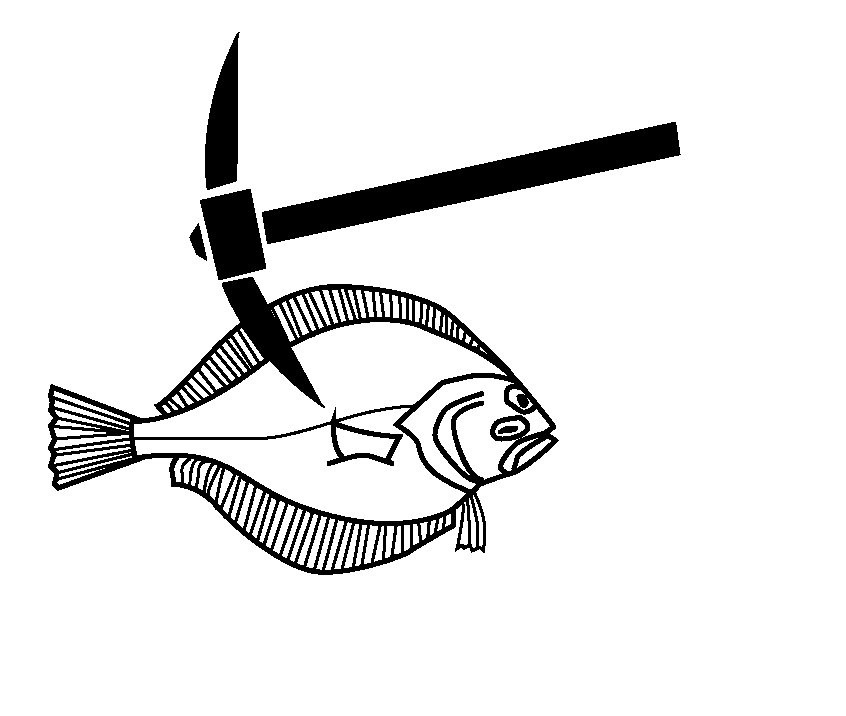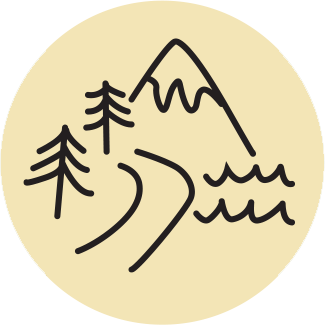
ADVENTURE AND EXTREME SPORTS
The landscape of the world, with its soaring peaks, drop cliffs, tropical jungles, array of underwater animal life, and bumpy overland terrain is meant to be taken head-on and not just viewed from a fancy hotel balcony. Feed your inner adrenaline junkie some quality adventure by tossing yourself into the canyons of Interlaken, carving your way through Canada’s powdery terrain, and slapping on a wetsuit to explore Australia’s Great Barrier Reef. Leave no stone unturned, no mountain unscaled, and unlock the next level of thrill by expanding your adventures worldwide. Everyone knows that adrenaline pumps hardest in unfamiliar territory.
 AUSTRALIA
AUSTRALIA
REEFER MADNESS
The largest structure on the planet made up entirely of living organisms, the Great Barrier Reef (GBR) is a live seafood soup filled with crazy-looking and endangered animals swimming at you from all angles. A UNESCO World Heritage site, this reef is home to 1,500 species of fish. Throw some scuba gear on your mammalian ass and discover what makes this reef so great.
SCUBA
The GBR stretches 1,600 miles along the Queensland coast in the Coral Sea, and the best way to experience it is to submerge yourself deep into its crevices. Eighty-pound grouper cruise by, schools of barracuda eye you cautiously, reef shark silhouettes loom in the distance, sea turtles float by, drunk on life, and Nemo feverishly defends his nest all around a reef of hard and soft coral that no box of Crayola could ever color-code. There are countless ways to see these billions of coral polyps. Here’s a short list to get you bright-eyed:
Cairns
The scuba capital of Australia has no shortage of tour agencies to get you to the reef. Shop around to avoid rip-offs or book at a well-reviewed hostel. The GBR is a long boat ride from Cairns, so an overnight trip is the best way to see it. You can get two days with three dives each (including a night dive) with food and lodging on a live-aboard boat for about $560. Some of these bigger boats feel like touristy assembly lines; make sure to check boat reviews online before paying.
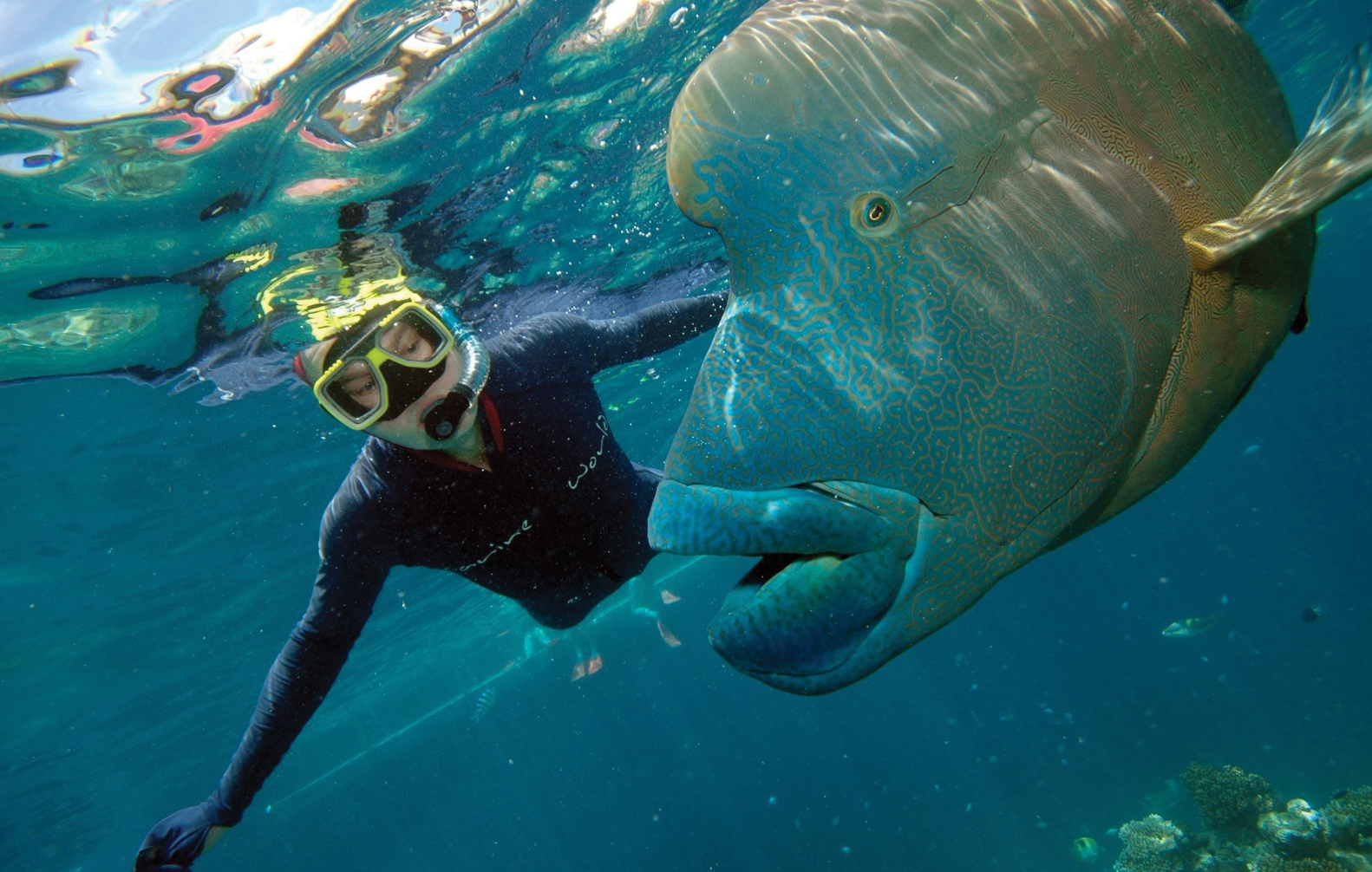
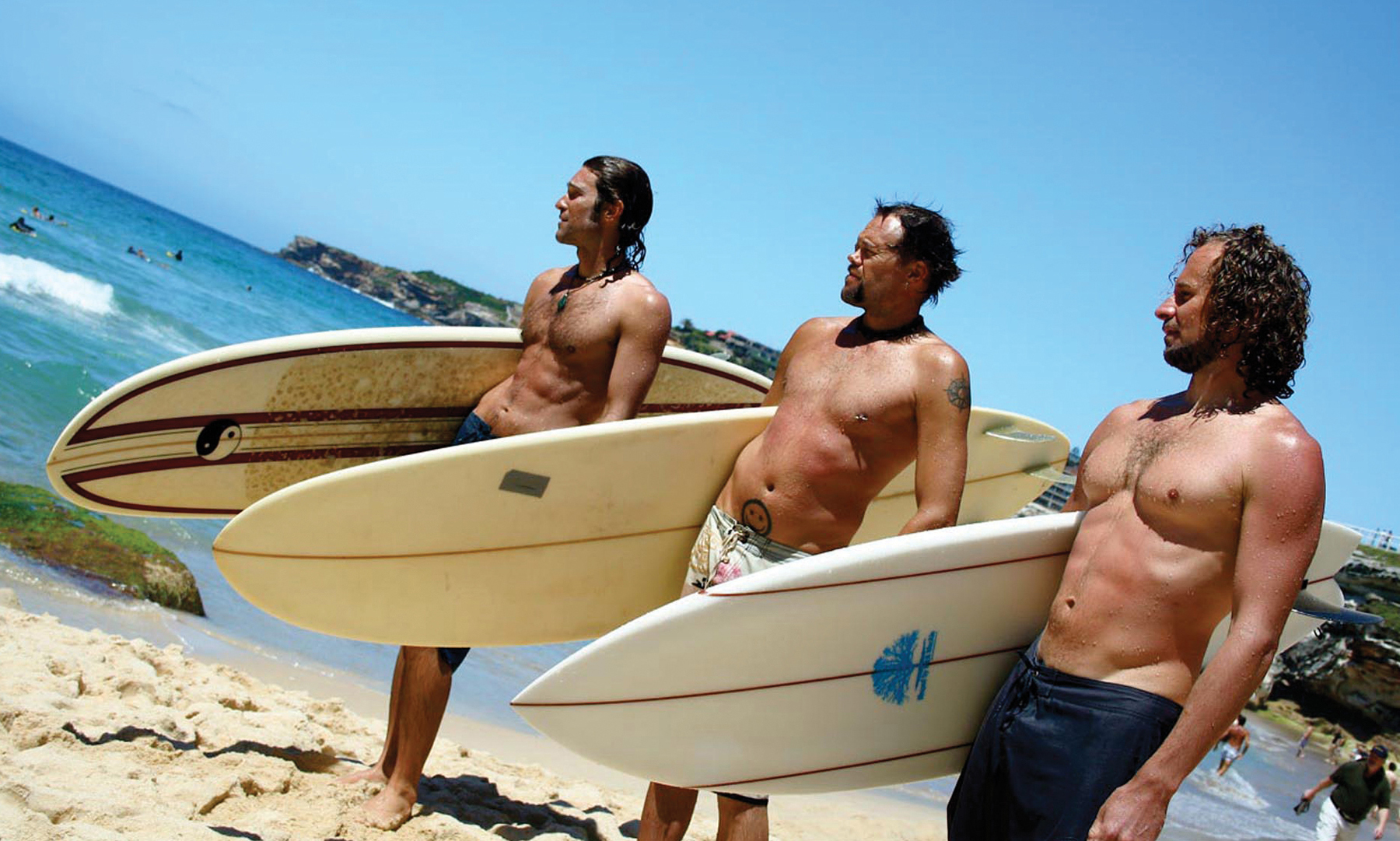
SS Yongola Wreck Dive
One hundred years ago, the SS Yongola passenger ship disappeared in a cyclone, along with all 122 people on board. This football field–size mass grave quickly became a cushy new underwater neighborhood, gentrified by the swankiest of fish. Local dive shops claim you see more species of fish on this one wreck dive than you do in ten dives anywhere else on the reef.
Shark-Feeding Dive
If you do a weeklong live-aboard jaunt out to the Osprey Reef, you’ll see the best collections of the reef’s sharks, especially when the dive ops run a shark-feeding dive at North Horn. Dozens of gray sharks, silvertips, and sometimes hammerheads and tiger sharks circle overhead and bolt past you for giant chunks of the provided fish carcasses. Try not to crap your wetsuit.
Too Legit, Too Legit to Quit
While it’s not as cheap as Asia or Central America, you can get certified to dive any-where along the reef. (Cairns cranks out more certifications than anywhere else in the world.) As a bonus, your four certification dives are actually at the GBR (as opposed to in some Midwest rock quarry). Snorkeling is a decent consolation if you can’t dive, but it’ll feel like a threesome gone wrong as you look longingly at the reef rather than being a part of it.
SKYDIVING
The GBR is visible from space. Don’t take our word for it—head up that way and see for yourself. Instead of squinting through a tiny airplane window, jump out of that bad boy for a better view. As wind relentlessly pummels your face and howls past your ears, you’ll hit terminal velocity in a sixty-second free fall that’ll seem like a lifetime. Once you’re jolted to a stop with the release of your chute, you’ll feel suspended in midair, soaking up the views of this world wonder.
The Great Barrier Reef is almost the size of Texas, but climate change is wiping it out faster than Windex wipes schmutz off a windshield. Already called the “So-So Barrier Reef,” the GBR is definitely dying. Get there before it’s gone.
 BOLIVIA
BOLIVIA
PACK YOUR MACHETE, THINGS ARE ABOUT TO GET WILD
Covering 2.3 million square miles across nine countries, the Amazon is a portal to a mysteriously green world unlike anything you’ve ever imagined. Here you can learn how to suck drinking water from vines and how to tell the difference between tree bark that kills and bark that’s rumored to cure cancer. You’ll cook over an open fire, spice up lunch with coconut-flavored grubs, and wash it down with mint-flavored ants.
THE SPREAD
The vast majority of the jungle is in Brazil, but digging through greenery there is fannypack-heavy and consequently more expensive. Cheaper and farther off the gringo trail, the Bolivian Amazon is concentrated in the northeast of the country. There are forty-six indigenous tribes in and around the 7,320-square-mile Madidi National Park—most of which is closed off to tourism. To get there, hop on a flight from La Paz to the small airport in Rurrenabaque, or risk a twenty-four-hour bus ride on the world’s most dangerous road.
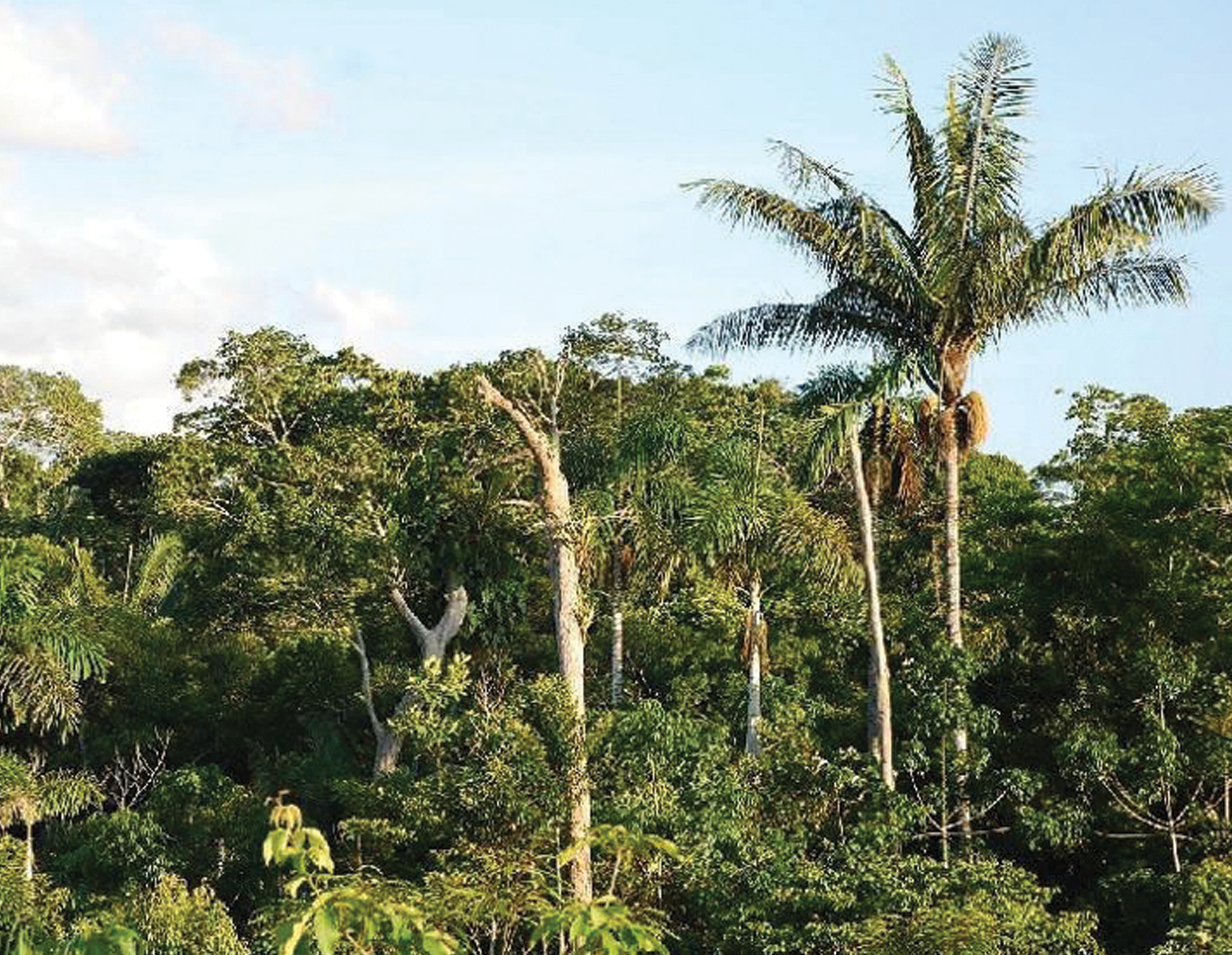
JUNGLE BOOKING
Rurrenabaque is a little like the American Wild West, a tiny dusty town without an ATM where locals wear a jaguar tooth as a badge of pride. It’s also where intrepid travelers hook up with true jungle men to go in deep. With a plethora of the most dangerous animals on Earth and unforgiving terrain, it’s almost sure death—not to mention illegal—to go exploring alone. You can book a trip through one of the many agencies that line the streets of Rurrenabaque. Most offer packages that include sit-down meals and a hammock at one of the several ecolodges in Madidi. Lush mountains and rolling banana plantations surround the park, and you’ll get there by a two-hour boat ride from town.
HACKING IT ALONE
If you’re looking to head out with just a guide and the pack on your back, some agencies offer more rugged trips. A couple offer full-on survival courses where you brave your journey with nothing but a machete and iodine tablets.
You will learn how to feed yourself in the wild, sleep with one eye open, and stand your ground in jungle confrontations (since most anacondas aren’t familiar with dismissive phrases like “fuck off”). It’s important to figure out what type of experience you want to have and ask as many questions as it takes to find the right guide or tour company.
If you want to bushwhack your way through the muddy brush, pick up a machete at one of the many hardware stores in town. And the bugs are brutal—stock up on DEET to keep the bites at bay.
 BORACAY
BORACAY
WATER SPORT BUFFET
Dipping into various water sports at one beachy destination is fun because you get to see the place from various perspectives while riding an adrenaline high, all without breaking a sweat. Many of the world’s beaches offer an array of water sports but charge a high price to play. A quick one-hour flight from Manila, Boracay has all the right moves to tempt you into permanent island residency—for prices that won’t get your Speedo in a knot.
GET YOUR WINGS
Using wind-power, kiteboarding (sometimes called kitesurfing) requires a specialty board and a big-ass kite that the rider controls to glide across the surface of the water. Like a multiadventure sport orgy between surfing, paragliding, wakeboarding, windsurfing, and snowboarding, kiteboarding is piss-in-your pants fun and Bulabog Beach is one of the best places in Asia to do it.
Bulabog Beach draws top boarders from all over the world to test their skills over foreign waters. Peak kiteboarding season is November–April, when the offshore winds blow just right and the primo boarding spot is a small lagoon protected from waves by a coral reef. Glassy water conditions make this a perfect spot for beginners looking to pop their kite boarding cherries, or pros who want to practice backflips on wave-free waters. If all you can manage here is a sloppy belly flop, at least you can gaze at the insane aquatic scenery while the sting wears off.


AMPHIBIOUS PURSUITS
If surfing the seas with the wind as your motor sounds like a kitemare, Boracay has plenty of other adventures under her saltwater-soaked skirt. Complete with coral reefs, canyons, and caves, scuba divers go googly eyed exploring the island from the underside. Hop on a jet ski, graze the water on a skimboard, or play the part of a pretentious speedboat asshole. However you feel like stirring up the ocean, you can do it here relatively cheaply and easily.
SAIL PAST THE CROWDS
It’s not in tribute to some surrendered battle or a pale-faced explorer; White Beach simply has white sand. Tons of it. Since people love that pillowy stuff, the beach is littered with bodies during the summer. Sift through the skimpy pickings or hop on a paraw (Filipino sailboat) to drift away from the swarm. Bargaining your paraw price with a Filipino sailor won’t require learning Tagalog, since most locals speak English. There are usually snorkels on board and your captain will sail you around even more remote beaches to really ditch the crowds —and possibly your bathing suit.
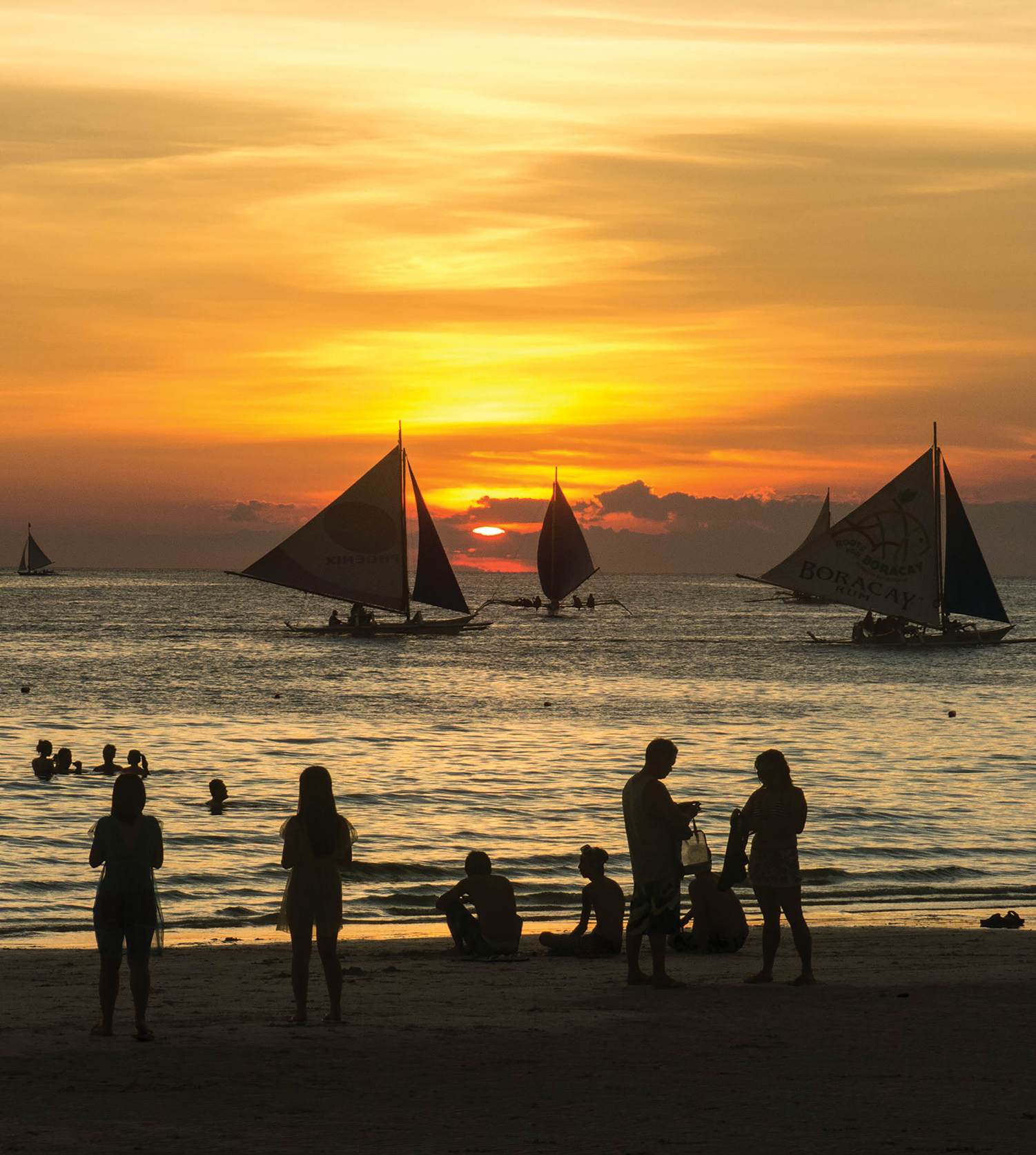
 CANADA
CANADA
EXTREME UNLIMITED
Bum a cup of kickass from our North American neighbor. Knock on Vancouver’s door on your way to Whistler Blackcomb, a monstrous snow resort that you can carve up until your lungs turn purple. Head down the street to Banff and load your ear canals with white water. And finally, get gluttonous in Quebec, the birthplace of the inevitable Canadian food coma, better known as “poutine.” This continental colossus offers adventure from every angle, with both winter and summer adrenaline-loaded adventures, just waiting to be manhandled.
WHISTLE WHILE YOU CARVE: SNOWBOARDING VANCOUVER
The holy behemoth of North American mountains, Whistler Blackcomb of British Columbia is often regarded as the greatest snow resort in the world, and is the place to put your shred sled to the test. Clip in your boots and carve a deep trail down these twin mondo mountains.
Coming Down the Mountains
With over 8,000 combined acres of boardable trails, the Whistler and Blackcomb mountains ensure that even the most serious of you snowbums will be happily bombing down the slopes all season long. Dozens of lifts lead to the 200-plus trails of fresh Vancouver snow canvases that await your craftsmanship. Carve your tightest S’s and master your jump turns down Blackcomb’s world-rated “Couloir Extreme”—a fifty-two-degree test of how much hell you’re willing to put your thighs through. Get tricky on the mountain’s Olympic-size superpipe, or head over to Whistler and race through the “Peak-to-Creek” perimeter tour trail of over four miles! Can’t decide which mountain you want to tear up today? Get on the “Peak 2 Peak” gondola—a record-breaking scenic ride of a lifetime that connects Blackcomb and Whistler.
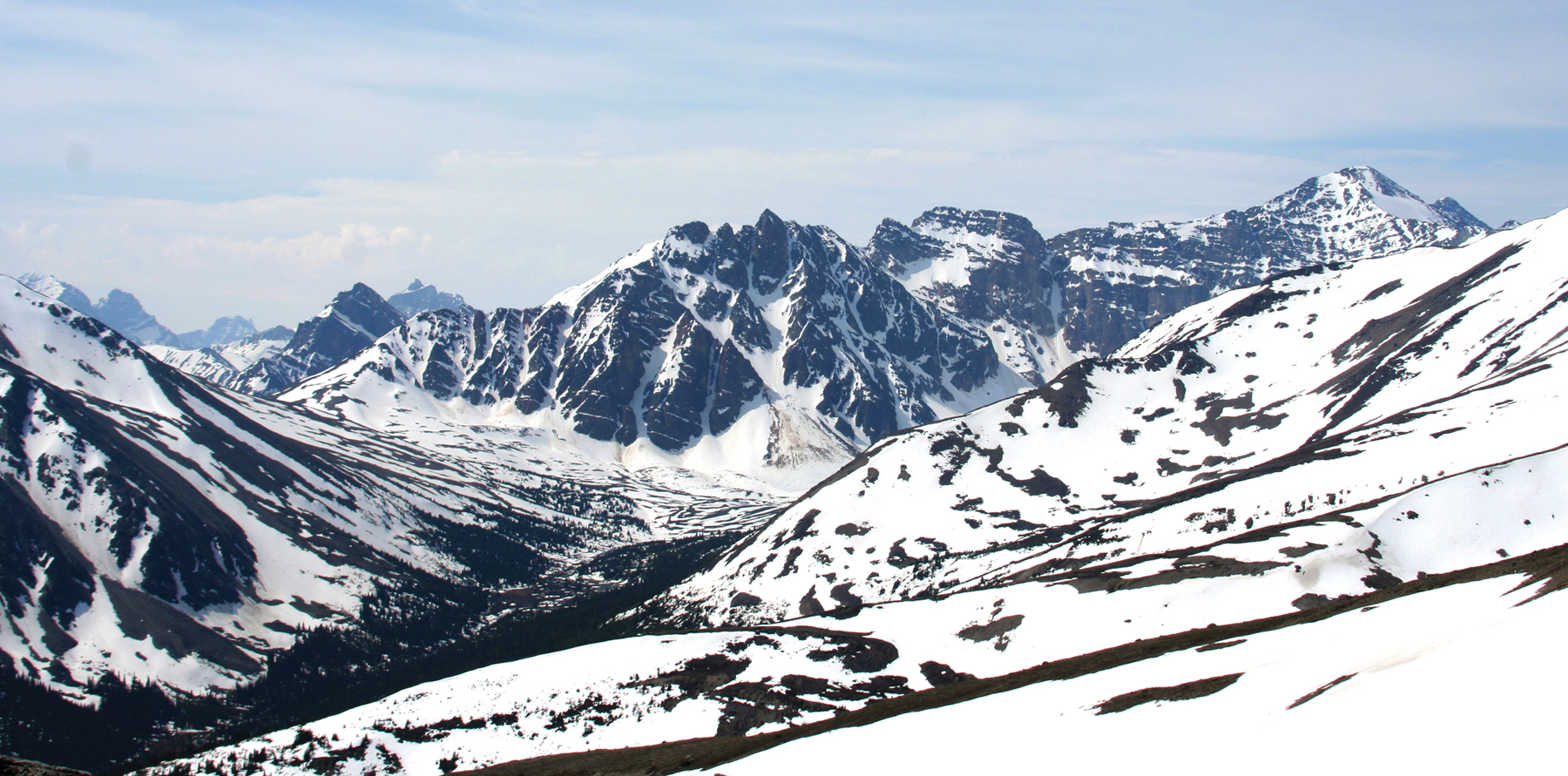
UNCHILL YOUR NIPS WITH POUTINE
Soften up your shirt-piercing nips with Canada’s trifecta of fat. Quite possibly Quebec’s greatest contribution to the planet, poutine is a big ol’ ball of cholesterol that can kill lesser men ill-prepared for its addicting glory. With globs of fatty juices and dripping in sticky goo, somewhere beneath its artery-clogging exterior is a Canadian treat that warms you to the core.
Pou-natmony
It consists of three ingredients, piled on top of one another: (1) French fries, (2) gravy, and (3) cheese curds. The fries are piping hot, golden, and somehow still crispy despite the gravy that covers them. The gravy is as thick and sweet as jelly. And the curds? Little nuggets of smooth dairy deliciousness melt into the pile and make little squeaky sounds with every bite. Just reading the ingredients will make you fatter, and it is truly a wonder how Canada’s morbid obesity rates are so low. What’s more, poutine is normally just a side dish to a main meal! You can essentially get the stuff anywhere across the country, short of Indian restaurants, from 8:00 a.m. to 3:00 a.m. most days.


WHITE WATER RAFTING IN BANFF
The Banff region of rocky Alberta, Canada, is notorious for its world-class white water and ferocious river rapids. A wise group of travelers (we) once said that the best way to know your mountainous surroundings is to raft right through them. Grab your oars and hold on tight—we’re gonna get you all Banff-ed and bothered.
Down Shit’s Creek—with a Paddle
Sometimes closed off to commercial rafting companies and always gushing with dangerously extreme levels of rapids, the Kicking Horse is the only river around here really worth paddling. The river carves right through Kicking Horse Canyon in three tiers: upper, middle, and lower. Naturally, the upper canyon (and the beginning of your trip) is friendly enough to find your groove. Miles downriver, the Portage and Shotgun rapids will quickly awaken the extremist in you. From here on, the fun and games morph into panic and survival; the bottom of the middle canyon and entire lower canyon are filled with challenging rapids that often arrive unannounced. Totaling over twenty miles, with a consistent water temperature just above freezing, Kicking Horse River will quickly put some commendable rafting experience under your belt.
Keep It Classy
As you progress downriver, you’ll start holding on to your oar for dear life (as you should) while smacking into Class III, IV, and even V rapids. What do these numbers mean? Quite simply, an Association of All Things Adventurous (actually called the American Whitewater organization decided to make an internationally recognized scale of how badly the water will kick your ass—aptly named the “International Scale of River Difficulty.” The scale divides rapids into classes from I through VI; I being a leisurely paddle over waves that wouldn’t disrupt a snorkeler’s breathing; VI being a green-conscious government’s alternative to the electric chair—almost certain death. Just so you know what you’re diving into, the lower part of the Kicking Horse, starting with Portage and Shotgun rapids, are rated a consistent III to IV and can rush to a V during unpredictable parts of the sport’s summer season. If you’ve got the rapids in a chokehold and your adventurous side needs more of a tickle, ask your guides to let you swim once the tour is over. Trying to backstroke down an icy-cold Class III rapid should sufficiently fire up your veins.
From mild to wild, the Kicking Horse River is easily the toughest route through the canyon. Take a one-day tour down or split the trip into a multiday excursion. However you plan to paddle, once you reach the bottom, we guarantee you’ll feel like you’re on top of the world.

 INTERLAKEN
INTERLAKEN
CRACKS, CREVICES, AND CANYONING
Canyoning is one of the most extreme sports out there. The concept is simple: use all means necessary to reach the bottom of a canyon. The execution is difficult: you’ll have to rappel, slide, climb, jump, and dive to make it out alive. Once you’re in this bitch, there’s no pulling out. You can’t just roll down a canyon anywhere there’s a crack. The conditions must be just right, and in Interlaken in Switzerland, you’ll find the perfect balance of steep cliffs, big drops, and roaring waterfalls.

Start From the Top
Jagged rocks, unimaginable heights, freezing-cold streams, and no sign of immediate escape: This is what Interlaken has to offer. So why would anybody voluntarily do this? Because it makes you feel alive, and you can only do it (and survive) in a few places around the globe. Canyoning (known in the United States as canyoneering) has been around for thousands of years but not always as a sport. Originally, native populations found refuge, shelter, and food in the deep granite and sandstone canyons of America’s west coast. It wasn’t until the 1960s that death-wish adventurers started exploring the ins and outs of Mother Nature’s deep, gushing crevices for sport.
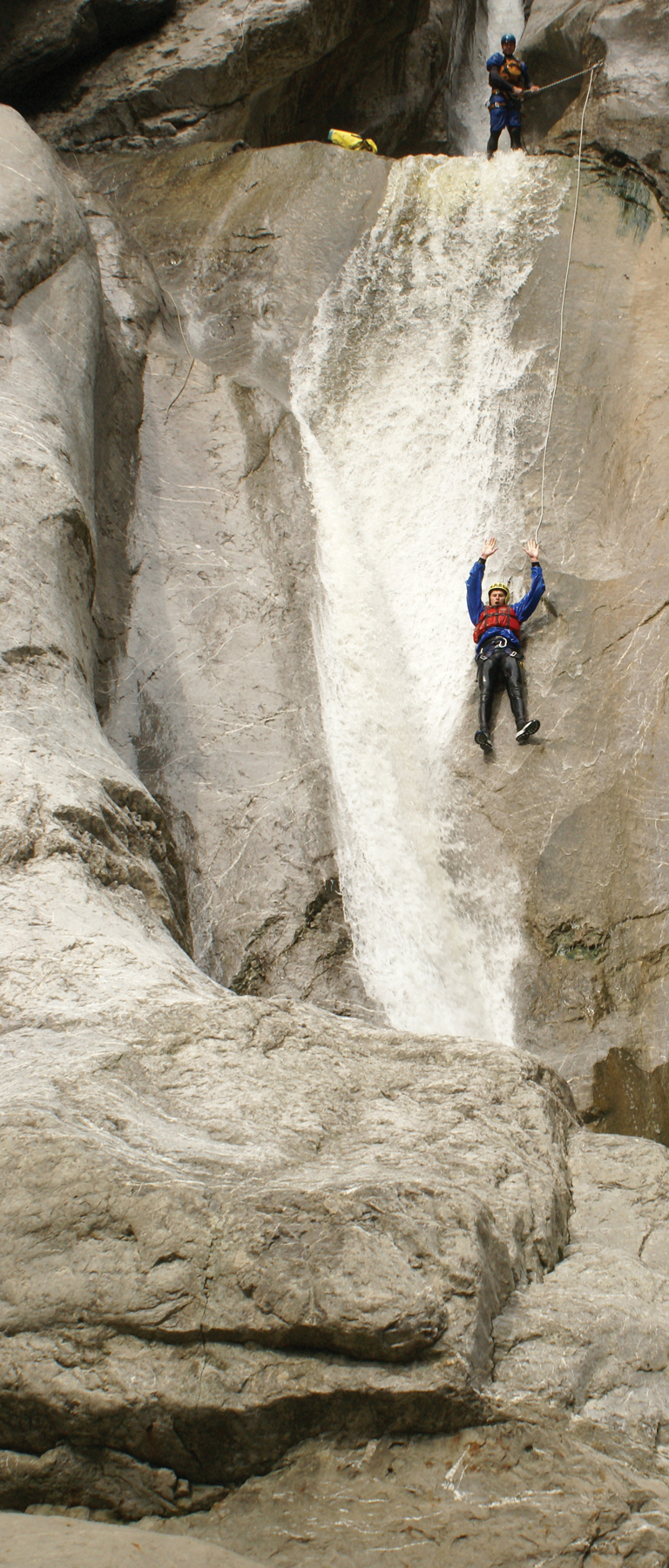
What Goes Down
In Interlaken, your adventures in the canyon begin at the top of a mountain. You’ll first change into protective gear and receive some brief safety guidelines (e.g., don’t jump off any fifty-foot cliffs without first telling a guide), then you’ll hike for a good half hour until you really feel alone in the canyon; that’s when the fun begins. The first dive into the freezing mountain water effectively evaporates whatever balls you have left from the provided nut-hugging wetsuit. The next three hours consists of jumping, diving, rappelling, sliding, swimming, and shivering down the canyon with a small group of as-crazy-as-you comrades. It’s an adventure of a lifetime, so you better be prepared. Tuck in your elbows as you go down nature’s own paved slides; they’re gonna get bumpy. Keep your knees bent on the cliff jumps; the landing pools can be shallow (remember to canyonball). Don’t fuck with your carabiners; rappels are a long way down. Bring a towel; you’re gonna get soaked. And definitely buy the individually edited HD video; nobody’s ever gonna believe you did this.

Choose Your Canyon
Interlaken knows your time and budget are limited, so your choices are simplified thanks to three organizations—Interlaken Adventure, Outdoor Interlaken, and Alpin Center. All three offer similar rates of around $300 for the trip. Since each company specializes in one specific canyon, choosing your package depends on which canyon you decide to conquer. Some are smaller and shorter, others are terrifyingly large. If you want to go for the biggest and baddest, choose Chli Schliere. Enclosed in tight rock walls over 300 feet tall and defined by huge waterfalls, these are the tallest jumps and slides in the region. With extremely challenging 100-plus-foot rappels, this thing will quickly show you what real canyoning is all about.
 NEW ZEALAND
NEW ZEALAND
FIVE WAYS TO TEAR THROUGH GLACIER COUNTRY
You won’t be in Glacier Country long before you realize this place sure as shit is not the Shire. Fed high from the Southern Alps, the twin glaciers that define the region—Fox and Franz Josef—trade rolling hills for deep crevasses and miles of meltwater that lead into icy blue abyss. Don’t go grabbing your groin for warmth just yet–we’ll tell you how to keep Kiwi cool while touring New Zealand’s greatest glaciers.
PADDLE ACROSS
Take to your oars and paddle a relaxing day away on New Zealand’s largest unmodified wetland, Ōkārito Lagoon. The overextended toenail on the foot of the Franz Josef, Ōkārito’s glass-smooth water surface will wind you through the inlets, channels, and rivers where the famously elusive white heron (properly known as kotuku) resides. If you’re in the “relax when I’m dead” school of thought, kick the action into overdrive and contact Eco Rafting. These guys make blitzing your heartbeat their business. A boatload of rafting options—like heli-rafting and multi-day excursions—will put some power behind that paddle.
CLIMB THROUGH
Make the hair on your chest grow Chia Pet–fast as you rappel down glacier cracks and crevasses guided by the day’s sun rays. Ice climbing is the most popular (and most demanding) sport in the area but isn’t as intimidating as it sounds. Getting a grip may feel weird at first, but rest assured that a harnessed-in team from either Franz Josef Glacier Guides or Fox Glacier Guiding will catch you if you fall. The awesome realization that you’re walking on thousand-year-old water comes with the package.

HIKE BELOW
From the tip of the glaciers, down lakes, through rain forests, and toward the Tasman Sea, Glacier Country is frigidly scenic. Tons of hikes wind through the terrains and reward you with panoramic glacial views. For Franz Josef, take the Pakihi walk and listen to the haunting call of New Zealand’s most endangered bird, the rowi. Mount Fox’s route will get you up close and personal with Fox Glacier and simultaneously test your strength—the one mile hike up to the peak takes four hours! Do the math, and do some pull-ups in preparation.

SOAR ABOVE
Add some height to your journey by sky-diving into the damn thing. Fox Glacier’s dives of 12,000 and 16,000 feet will ensure that you get your adrenaline rush and you get it good. Take in the view of the glaciers and rain forests during the flight of anticipation before you jump straight out and become part of the landscape yourself.
SINK IN
Long days of adventure can take a toll no matter how ripped and ready you think you are. Before heading back, sink into the hot pools of Franz Josef. According to local legend, the tears of Hine Hukatere, an ancient adventuress—wept for the fall of her husband during a climb—are the water source of Franz Josef Glacier. Bathe yourself gloriously in her hot misery to work out your kinks.
 CUZCO
CUZCO
MUCHO MACHU PICCHU
No one knows exactly why it’s there, how it was built, or what type of magic it can harness, but a trip to South America is incomplete without a climb to Machu Picchu. The world is full of overhyped tourist spots; this isn’t one of them. This massive Incan complex solidly deserves its title as one of the New Seven Wonders of the World. Just sixty miles north of Cuzco, Peru, the capital city is where the mind-blowing pilgrimage begins. You can fly into Alejandro Velasco Astete International Airport, take a bus, or big pimp it and float into Peru via the Amazon.
OTP Tip: Machu Picchu sits between two mountain peaks—Huayna Picchu and Machu Picchu Montaña. Uncrust your eyes before dawn to see the clouds rising over the ancient complex from atop either peak. You can hire a guide at the park entrance should you need some early morning trekking assistance.
WHY WONDER?
American explorer Hiram Bingham found more than 100 skeletons when a local boy led him to the complex in 1911. The Incans had mysteriously constructed 140 temples, mausoleums, vaults, and houses out of giant stones with their bare hands, right into steep Andean slopes.


No one knows why the city was abandoned thousands of years ago. Some people think aliens built it to bring civilization to man; others believe its structures form a psychedelic astrological calendar.
OTP Tip: An ISIC (International Student Identity Card) will get you 50 percent off entrance admission. Tickets are only good for the day they were issued—if you oversleep, consider your cash gone.
TREK IT OUT
While Machu’s downfall is shrouded in mystery, one thing is known for sure: The Incans didn’t fuck around when it came to stairs. Any real trip to Machu Picchu includes 100 or so flights of uneven stone stairs to get to the complex entrance. If that doesn’t set your ass on fire, you can also do a three- to five-day trek along the Urubamba River to fully earn the insane view. The Incan Trail is tried-and-true, and a spot on an organized trek with any number of agencies in Cusco will run you about $600 to $700. Prices include park entrance, a tent, food, a Peruvian guide who knows his shit, and a donkey to carry yours.
Everyone has seen the played-out pictures of Machu Picchu by now. But no picture can capture the crispness of Peruvian mountain air, the size and scale of the complex, and the deserved soreness raging through your body the next day.
OTP Tip: Ditch the crowd all together and tame those mountains with a map and sheer willpower. You don’t need a permit to do the Salkanty or Choquequirao trails sin guia and the donkeys could use a breather.
FLOAT YOUR WAY OUT
If you’ve had your fill of mountains in Peru, change up the scenery by hitching a ride to Brazil via the Amazon. Much more scenic than a cloudy plane ride, the Amazon is over 4,000 miles long, can be up to twenty-five miles wide, and is filled with plants and animals even Wikipedia has a hard time describing. The major artery of South America’s heart, the Amazon is sometimes the only road that connects points A and B. You can pay for a bus or a flight to get to the jungle, or milk it like a jaguar cub and get there for free. All it takes are some courage and sea legs.
The Road Less Traveled
The most-traveled route on the Amazon is from Iquitos, Peru, to Manaus, Brazil, with a connection in Leticia, Colombia. These rivers are technically tributaries of the Amazon, which begins for real in Manaus, but have plenty of piranhas, pink dolphins, tiny ports, and jungly shores to keep your senses occupied en route.
Get on a Boat!
Prep your Spanish sailor lingo and stroll on up to the port in Iquitos, flex your guns and tell them how you “worked on your uncle’s sailboat that one summer.” Though some boats ferry up to 600 passengers, they’re primarily cargo ships that carry anything from TVs and sound systems to chickens and grains. You’ll probably sacrifice your back for several days hauling cargo, but if you know your rice and beans, weaseling your way into the kitchen may be an option.
Chillin’ on one of these boats is an experience that romantically sits somewhere between a no-holds-barred jungle safari and an eighteenth-century prison ship. Catch some gnarly bugs, learn a couple samba moves, and drink your way into a Peruvian sunset. You will sleep in a hammock on the deck and love every moment of your successful labor-for-travel trade.

 SCOTLAND
SCOTLAND
HIKE UP YOUR KILT FOR AN EXTREME STROLL
A nation that normally lets it all hang out, Scotland has many best-kept secrets, one of which is the ninety-six-mile hike through Rob Roy country along the West Highland Way (WHW). The “Way” begins in Milngavie (pronounced Mul Guy) just north of Glasgow and ends in downtown Fort William at a statue of a man rubbing his tired Scottish feet. The trek will take you through Grimm’s fairy tale–like forests, around the banks of bonnie Loch Lomond, up steep and rocky hillsides, across farms with curious sheep, and deep into the eerie and isolated Rannoch Moor.
THE WAY
Most trekkers head out in May when the weather is best, the baby lambs are rambunctious, and the midges (small mosquito-y bugs that swarm and bite the bloody hell out of you) aren’t prevalent. For a more extreme trek, schedule your hike in the winter with gale-force winds and snowdrifts that obscure the path. An ice pick, instead of a hippie walking stick, is recommended during this time.
If hiking ninety-six miles isn’t enough, you can tack on another crazy seventy-nine miles along the Great Glen Way and cuddle with the Loch Ness Monster, who presumably hangs out in Inverness, the hike’s endpoint. There are also plenty of day trips along the way, such as climbing Ben Nevis and Ben Lomond, as well as several other Munros (a Scottish mountain with a height over 3,000 feet).

The Way of the Way
An unspoken mandate of the West Highland Way is to stuff yourself stupid on hearty Scottish food while covering those daily half- (and sometimes full-) marathon distances. One of the iconic landmarks near Loch Lomond is the 300-year-old pub, the Drovers Inn.
This haunted, tumble-down establishment is where cattle drovers stopped for a pint and some haggis as they moved their cattle down from the Highlands for sale and export. Vegetarians wanting to try the local fare can order the neeps and tatties vegetarian haggis, or Scotch broth soup.
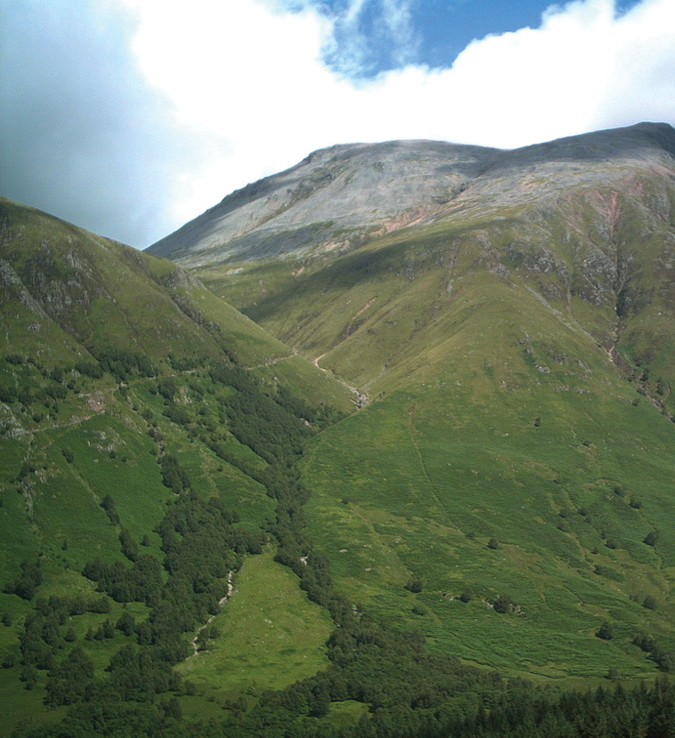
The Rowardennan Hotel, another stop along the Way, offers up a meal with a view overlooking the eastern shores of Loch Lomond. The food tastes like manna, and the beer is perfect for washing down your blister-numbing ibuprofen. If your feet call it quits, the hotel offers cheap bunk beds to hold you over until you feel Braveheart-good again.
SLEEP FOR FREE
While staying at bed-and-breakfasts is an option, it’s cheaper (and more fun) to pitch a tent and camp your way through the hike. Per Scottish law, wild camping is allowed except in places where it is posted otherwise—specifically Rannoch Moor—as long as you pick up after your grizzly self and use a civilized camp stove. If indoor plumbing sounds attractive every once in a while, there are designated campsites (with food options nearby) and hostels scattered along the trail, as well.
If you’re partial to pristine streams, mossy pine forests, views of Scottish lochs, and glimpses of feral goats and shaggy cows, coupled with giant blisters, missing toenails, and burning muscles, pull up your man-skirt and get trekking.
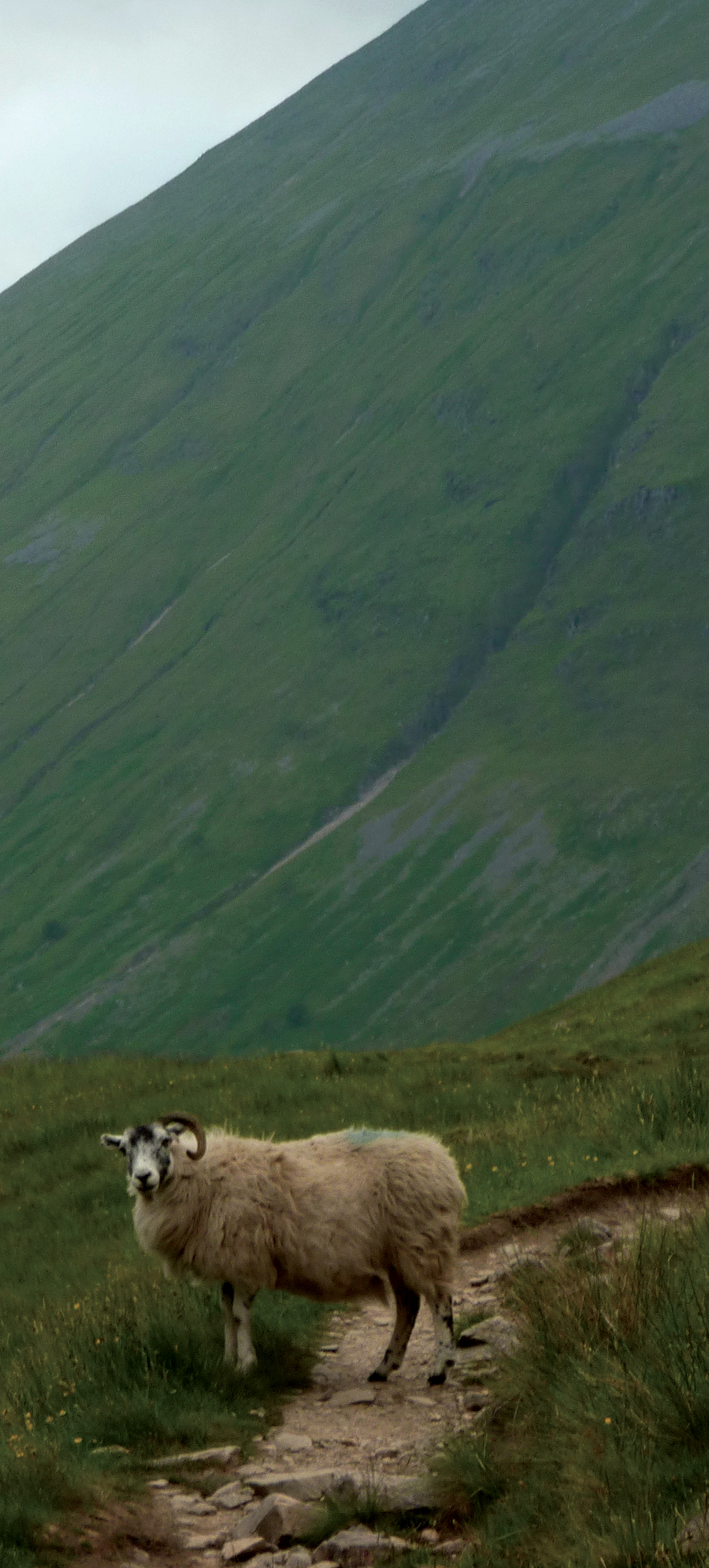
 SOUTH AFRICA
SOUTH AFRICA
GET HIGH, GET LOW, GET SCARED
Most thrill-seeking backpackers first experience Africa by way of South Africa, a country that mashes together some of the best extreme adventures available worldwide. Sure you can Jeep around on a safari, but here are three equally amazing ways to work at least one near-death experience into your trip.

GET HIGH: TABLE MOUNTAIN
Have yourself an adrenaline picnic atop Cape Town’s Table Mountain, a landmark you can either admire from the beach, take a cable car to ascend, or climb like a rabid beast. Tackle the tougher (adorably named) routes such as Double Jeopardy or Mary Poppins and Her Great Umbrella to prove your prowess. Once your feet are on the mountain’s defining plateau (the “table”), peek through the tablecloth of clouds to get tasty views of the Indian and Atlantic oceans, Robben Island (where Mandela was imprisoned), and all of Cape Town. If your inner junkie hungers for more, have yourself an abseiling adventure and rappel off the side of the mountain. Ropes chaffing your baby-bottom? Diving into Kamikaze Canyon’s natural pools should fix you right up.
To nail down unique sleeping arrangements, rev your flaccid calves and take on the Hoerikwaggo Trail from Table Mountain to Cape Point, which includes a stop in the Orange Kloof Forest. While wild camping is forbidden on Table Mountain, you can spend the night in one of the designated camp areas at Orange Kloof Tented Camps on a trail starting from the Silvermine Dam. These camps hook you up with everything you need so you can pass out under the Table, safari-style.

GET LOW: SURFING SOUTH AFRICA
In South Africa, people don’t just catch waves, they hunt down massive, rolling aqua giants and shred them apart, savoring every bubbling bit. Show off your mad surfing skills by tearing through some of the best waves in the world. For surfing near Cape Town, grab the commuter rail out to Muizenberg, where you can rent wetsuits and boards (and instruction if you need it). Keep your head above water and your ears open for shark sirens.
To get deep into the local surf culture, head to Jeffreys Bay (JBay to the natives), near Port Elizabeth. You won’t find too many tourists (unless you go during the Billabong surf festival in July), but you will find enough waves to slap you silly until the sun goes down.
To tackle the biggest breed of wave around, head to Dungeons in Hout Bay. Thirty-foot swells are on the menu at Cape Hout, which is best reached by boat from nearby Cape Town. Successfully tackling these demons will put you up there with the pros who’ve competed here for Red Bull’s Big Wave Africa events.
GET SCARED: SHARK DIVING TILL YOU CRAP YOURSELF
If the shark tunnel at the local aquarium is the closest you’ve been to a Great White, get ready to loosen your bowels with the terrifying fun of shark cage diving in the waters of South Africa, where the finned fishies swim. Most expeditions leave from Gansbaai, a fishing village near “Shark Alley.” The Alley is a narrow channel between two small islands where sharks love to chomp on the Cape fur seals that congregate in the area. No need to be dive-certified—just make sure you have an intense desire to piss in a wetsuit when a Great White slams up against the cage.
 TAYRONA
TAYRONA
CAMPING IN THE JUNGLE
Right on Colombia’s Caribbean coast is the tropical jungle reserve of Tayrona National Park. Colorful flowers, trees with surfboard-size leaves, monkeys, lizards, hundreds of bird species (we caught Toucan Sam red-nosedly snooping through our pack), and even jaguars live up the mountains and down by the beaches of this Colombian paradise. With cheap hammocks, huts, and tents up for rent, you can take up residence, too.
CHOOSE YOUR CAMPGROUNDS
Tayrona is a wildly popular destination for backpackers looking to explore, party, and relax just like you. Being a natural reserve, you can’t just plop your ass wherever. Thankfully, three sections for camping keep your options simple.
Cañaveral is the closest campsite near the entrance of the park—it can actually be reached by car. Known for its $275/night beachfront Eco-Habs, Cañaveral rents $20 nightly tents near the beach with surprisingly clean showers and shitters to boot.
Arrecifes is a one-hour hike through the jungle from the tip of Cañaveral. Once you make it, Bukaru is your best bet for camping with hammocks, tents, and cabanas available from $12 a night. As beautiful as Arrecifes’ beaches are, they’re deemed unswimmable by the park due to the ocean’s rapidly changing strong currents.
Cabo San Juan is the place to be, and it’s another hour deeper than Arrecifes. If you’re lugging loads of stuff, rent a horse and have it do your hauling for $18. Sleep in a sheltered hammock by the beach for $12, try a tent for a few more, or bring your own and sleep for $9 a night. Whichever way you sleep, your days will be spent like they should be: eating good food at the campground’s restaurant, living among awesome wildlife, and relaxing on the sandy beach.


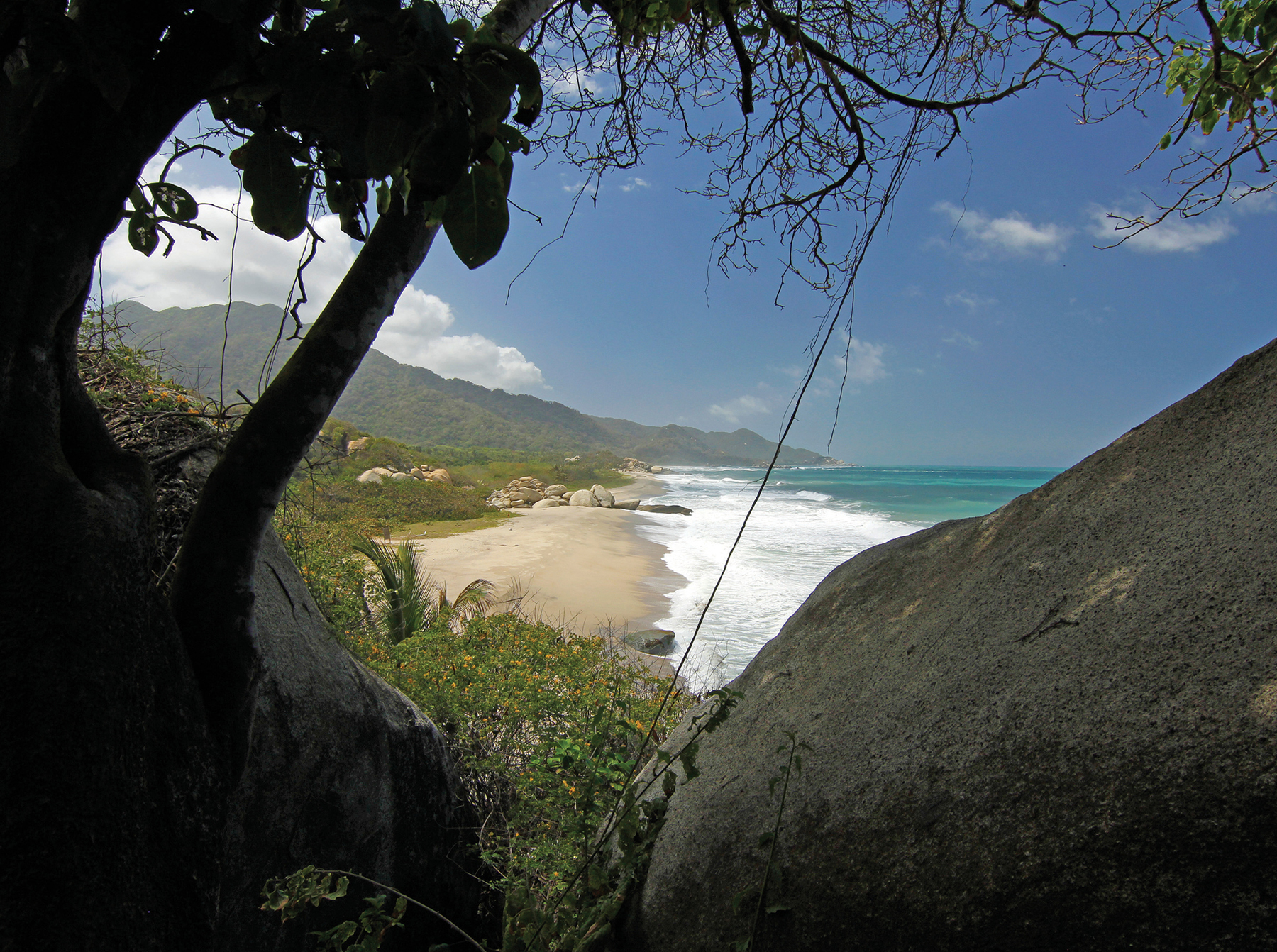
FILL YOUR DAYS
With seventy square miles spanning over two completely different ecosystems—mountain and sea—Parque Tayrona won’t short you on stuff to see and do.
One with the Sea
You can swim everywhere along the Park’s coast except Arrecifes. All the beaches are insanely beautiful, and protected Caribbean coral with colorful fish also make for great snorkeling. Bonus: there’s a nudist beach.
OTP Tip: While a few camp “restaurants” may have you thinking otherwise, the dining at Cabo San Juan is better than decent. Go for a $5 spaghetti plate or try a local ceviche–fish soup, always caught fresh from the ocean you’ve been swimming in.
Mountain Magic
Hiking is a good way to dig deep into the inner beauty of this preserved park. Venture a few hours beyond Cabo San Juan until you reach the ancient town of Pueblito. If the archaeological ruins of a small, ancient civilization don’t interest you, maybe the surrounding beaches and sounds of the Colombian jungle will.
Rumble in the Jungle
Parties are more eventful in the dark. The most nightlife you’ll find in Tayrona is around a campfire where local musicians rock out to traditional tunes. Serious amounts of alcohol are consumed and the rest of the night is up to you—just know that those beachside hammocks can support two.
 USHAIA
USHAIA
THE SOUTHERN EXTREMITY
If vigorous tango dancing isn’t enough to shed the meat-feasting pounds you put on in Buenos Aires, it’s time to head south—all the way south—to the southernmost city in the world. Ushuaia, the ice-cold heart of Tierra del Fuego, is your adrenaline nerve center in this rugged remote tip of Patagonia. Light a match under your parilla-enlarged ass and burn through the “Land of Fire.”
TIERRA DEL FUEGO NATIONAL PARK
Tackle the Americas’ southern tip in Tierra del Fuego National Park, where remembering you’re at the Earth’s end is easy. You rarely see another soul deep in the 240-square-mile Into the Wild–esque terrain. The park replaces human contact with mountains, glaciers, forests, waterfalls, and lakes all perfect for hiking, climbing, fishing, and good old-fashioned, nonmasturbatory alone time.
KAYAK THE BEAGLE CHANNEL
The rough, frigid waters of the Beagle Channel are often sailed, but jump in a lesser boat (like a kayak) to get closer to the wildlife here. Sea lions swim alongside your kayak, the albatross circle appears overhead, and penguins stand at attention on shore. You can navigate your seacraft through icebergs and watch giant ice chunks calve off glaciers into the channel. Charles Darwin cruised this waterway on the trip where he started asking questions that, still to this day, piss off school boards across the Bible Belt.

CLIMB THE MARTIAL GLACIER
Back in the day, this entire island was one monster glacier. Nowadays, only a few chunks remain. The Martial Glacier is just outside of Ushuaia and can be climbed in one good day’s hike. Bypass the ski lift that shuttles old people to the glacier’s base and attack the steep hour-and-a-half trail on foot. From here, you can climb up and around the glacier to get postcard views of Ushuaia and the Beagle Channel. There are signs warning you not to do this without a guide, but let’s just say you can’t read Spanish, gringo. Best of all, the entire day is completely free.
GO EVEN SOUTH-ER
You’ve come this far—why stop now? Ushuaia is the main launching point for cruises to Antarctica and if you need this one last pin to stick in your world map, this is where you start. It may be hard fitting this trip under your credit card limit, but if you can scrounge up the change somehow (bake sale?) you’ll be able to cruise among whales, cut through massive icebergs, get pummeled by unforgiving waves on Zodiacs rafts, hike across jagged glaciers, march with penguin colonies, and get chased by sea lions on this land that man has yet to fuck up. Seven countries claim territory on the uninhabited continent. Stick your own flag into the southern final frontier.








